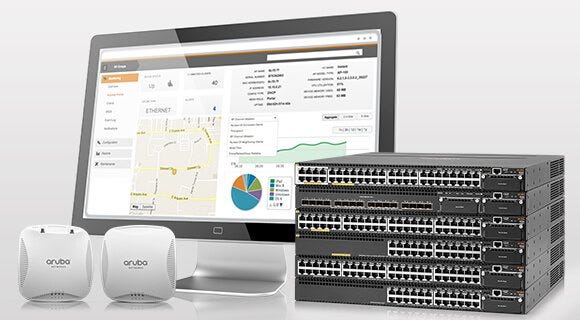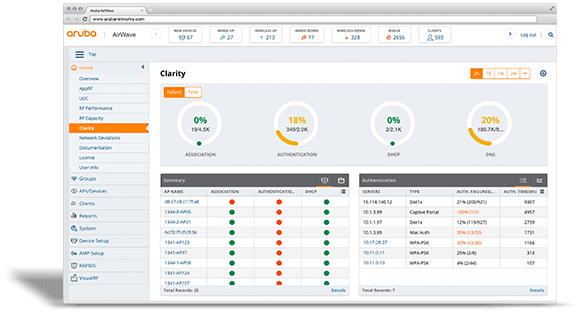Aruba has been a leading brand in wireless network solutions since it was released in 2002. After merging with HPE in 2015, the analysis by independent organizations showed that the brand continues to be a leader both in a wireless network and cabled network technologies segments. (For example, Gartner’s report compares the global manufacturing companies and assess the manufacturers.)
Aruba has patented technologies to always enable users to connect to the most accurate wireless access device. All users that connect to the wireless network with these technologies are directed to the most accurate Access Point and the most efficient performance can be delivered to the users.
Client Match: Client Match works like this. The system observes all users and APs that connect to the wireless network and when a user decides to connect to a wireless network, the system directs the user to the most suitable AP. This way, the most efficient Wi-Fi environment is provided for the user that connects to the wireless network. Client Match technology is a patented technology by Aruba and prevents more than 90% of the devices that connect to a wireless network to experience Sticky Client problems.
You can easily manage the systems installed with Aruba products on controller and airwave (NMS) as cloud-managed or hybrid architecture with on-prem, ESP (Edge Service Platform) architecture. The hardware can work as hybrid architecture depending on the need. In Aruba’s hybrid architecture, devices can work to be managed with ESP (cloud-managed), on-prem controller (Campus AP) and without controller (Instant AP) architectures. The hybrid architecture of Aruba and the opportunity to transfer between architecture is one of the differentiation points of Aruba from its competitors in terms of hardware and management.
Aruba ESP architecture especially enables distributed architecture network manager easier. The APs or switches on the field can be energized to automatically access to Aruba cloud platform (Aruba Central) and automatically operate the cloud configuration with field operator no-intervention ZTP (zero-touch provisioning) property. The operational costs of the installation can be significantly decreased with this method.
AI-supported ESP platform can identify the problem on the network before occurring or the recommendations about the problem can be instantly viewed by the system admin. Thus, it is possible to solve an existing or possible problem without losing time. At the same time, artificial intelligence-based recommendations are provided for more efficient system operation. For example, all systems managed by Aruba Central is considered and artificial intelligence can provide the suitable configuration or system to the system admin. Aruba ESP has the same controller architecture for both cable systems and wireless systems and provides user, traffic and device visibility by securing the network from the end with Zero Trust Security concept with L7 stateful firewall, application-based QoS and DPI (Deep Packet Inspection).

Aruba Controller technology has a pioneering architectural structure. With this architecture, APs in the environment can build secure tunnels for the Controller and direct the entire user traffic on the network with end-to-end encryption to the Controller. Additionally, there is no need for additional configuration for the ports that APs are connected to switches for SSIDs working on different VLANs. This decreases workload and personnel need and significant benefit to organizations in terms of optimization.
Aruba’s Controller has a firewall. Thus, all users from the wireless network can be filtered from the “stateful” firewall without additional hardware and enter the corporate network. Another plus of the firewall is that it is role-based. Thus, when users connect to a wireless network, the user group in the Active Directory can take different roles depending on the states such as operating system, access rules can be defined and prioritisation for Service quality (QoS) can be done.
DPI (Deep Packet Inspection) can permit an in-depth look at the entire wireless network traffic and app-based identifications can be done for the user traffic for prioritization.
The following technologies can be implemented with Aruba solutions to increase user and system performance and for corporate-level solutions.
Wi-Fi 6 & Wi-Fi 6E
Low latency for users can be achieved for LTE-5G-like levels. Wi-Fi 6 and OFDMA that comes with it can use the atmosphere environment more efficiently and Wi-Fi operation performance can increase especially in busy places. Aruba Wi-Fi 6 technologies have a wide range of products. It is the first manufacturer in the market by releasing a product at Wi-Fi 6E standard that is recently announced and enable 6 GHz usage.
Advanced Cellular Coexistence (ACC)
Advanced Cellular Coexistence (ACC) is a hardware filter that decreases the interference of GSM operators due to 3G/4G/LTE cellular networks. Thus, the wireless network performance is at the top level. Aruba supports this property for all AP since 2010 in terms of hardware.

iOT Support
Aruba APs have built-in protocols such as BLE and Zigbee for IoT devices. It has a built-in USB interface for sensor and actuator connections that broadcast with different radio frequencies from wireless frequencies such as 800/900 MHz.
Air Slice
All traffic can be prioritized for L4/L7 rules in DL (downlink) or UL (uplink) directions to increase the end-user performance and efficiency with Wi-Fi 6 AP and who will get how much can be set according to related QoS settings. With the integrated stateful firewall in the Aruba systems, app-, role- and user-based dynamic channel slicing can be done. Air Slice is a patented technology of Aruba.
WiFi6 Aware ClientMatch
In intense environments, simultaneous connection with Wi-Fi 6-supported devices is not expected from all users. The users will continue to have 5 GHz-supported Wi-Fi 4 (802.11n) and Wi-Fi 5 (802.11ac) devices in their Wi-Fi networks. With Aruba WiFi 6 Aware Client Match, you can automatically group in certain APs without manual effort for Wi-Fi 6 users in an environment and efficient wireless network communication can be provided.
Airmatch
With Airmatch, 20/40/80 MHz bandwidth usage in next periods depending on the wireless network system usage period density can be automatically applied with machine learning capabilities. The past state of the Wi-Fi system can be checked and the channel, power value and channel width for APs can be dynamically determined.
Live Upgrade
You don’t need to update the firmware at night for new properties. Live Upgrade property that comes with Aruba OS 8 ensures uninterrupted system update even during office hours. During the update, one of the Controllers inside the Cluster is updated first and APs are updated one by one respectively. Thus, the system can be updated without any interruption.
Multi-Version Support
Aruba’s unique solution to manage multiple controllers on a single interface that is the central wireless network architecture management called Mobility Conductor enables operating different versions of the controllers.
AP Load Balancing
The controllers inside the cluster in the clustering property that comes with Mobility Conductor can work in the active-active format and provide a dynamic load-balance to all controllers in all AP groups that end on the cluster. Thus, the load balance can be equally distributed on controllers inside the clusters. Which controller do the APs end is dynamically determined by considering the states such as AP load, traffic and number of connected users.
Client Load Balancing
Some users connected to APs load balanced in a cluster group might be terminated on a controller that the AP has terminated or on another controller. Thus, the traffic created by the users is equally divided among the controllers in the cluster and the traffic load on the controllers is balanced.
Hitless Failover
A copy of the user traffic load balanced inside the cluster is created on another controller in the cluster. Thus, if a user is terminated or if the active controller is down for any reason, the user can continue uninterruptedly on another controller inside the cluster with backup traffic. Mission-critical applications and real-time apps such as voice, video, Skype, MS Teams, Zoom, Wi-Fi calling can operate uninterruptedly when the controller is down.
The recommended solution approaches for corporate networks expressed in the network and system security and architecture titles in Presidential Digital Office Circular can be easily and rapidly activated and managed with Aruba’s abovementioned properties. The items in the Digital Transformation Office document are approaches and solutions that are actively used by institutions that use Aruba architectures. It is not possible to reach the solutions listed on Presidential Digital Office Transformation Circular with competitors’ solutions or these alternative solutions aren’t at sufficient level to meet the technical requirements. Further, an integration process is needed for different solutions. The abovementioned Aruba network, security and management solutions are offered under a single platform that provides fast adaptations to network and security architectures expressed in Presidential Digital Office Transformation Circular for institutions.
In terms of network products, the sector-based enterprise products are 58% Cisco, 51% HP Aruba and 1% others in Turkey.
This is 85% HP Aruba (campus-boutique), 10% Cisco and 5% others in the education sector. In Turkey, approximately 85% of the private schools and 80% of the universities use HPE Aruba products.
Sources:
- arubanetworks.com
- gartner.com
- cisco.com
- extremenetworks.com
- commscope.com/ruckus
- wikipedia.org
Gartner reports for the years 2015, 2016, 2017, 2018, 2019, 2020






